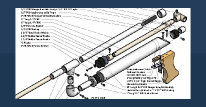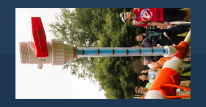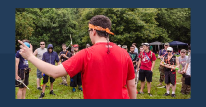Secondly, here's what you'll be building:

It's an over-and-under Raider. Very simple. The point of this writeup is to show a few small pitfalls and design nuances.
===
Tools:
- Hacksaw
- File or power sander
- Small Philips screwdriver
- Power drill
- Razor blade
===
Materials:
- Electrical tape
- Epoxy
- Epoxy putty (optional, read on)
- Hot glue
- Self-adhesive felt
- 3 x narrow zip ties
- rubber bands
- 2 x plates 4-1/4" x 5-1/4"
- 16 x #6 nuts
- 16 x screws or 8 x 3" #6 bolts (and an additional 8 x #6 nuts)
- A white kitchen garbage bag
- A Ziploc bag
===
To start with, hacksaw the handle off the priming ... well, handle.

===
Open the Raiders. (Duh!)

A few tips here:
- I had the first one go SPROING! all over the place. The second one I opened in a white garbage bag. Much better.
- The front has two deep pegs, so it will take some prying along the track to get the shells spearated.
- To further cut down on the SPROING-age, pry apart the back a mm or two, then guide the spring out. Even unprimed, it's precompressed.
- You can lose the white part and the orange tactical rail accessory catches.
===
(Not shown) Remove the guts. Stow the small parts in Ziploc bag, and the larger ones in the garbage bag.
===
Saw off the pistol grip and trigger guard

You can do it along the contours of the blaster like I did, which will REMOVE THE TRIGGER TRACK, or you can saw it off a little lower on the handle which will be less aesthetically pleasing.
While my motto is indeed "Fugly is a feature," this will be used by someone else, so I'd like to make it purty. If you cut lower on the handle, you won't need the e-putty. See Cygnus' original Maurader for where to cut.
==
File down the bumps along the tactical rails.

Yes, there are a lot of them (36 pair, thank you for asking), but it's better to have the tops flat to maximize the surface area for the epoxy.
This is where a power sander is good. Or, lacking that, ibuprofen for your aching elbow the next day.
==
Lay electrical tape along the tops of two shell halves
Specifically, I am taping the left *full* (lower) shell and the right *chopped* (upper) shell. These shells will NOT be fused, hence the tape.
The end result will be that the Siamese shell will contain the full lower blaster's right shell joined to the chopped upper blaster's left shell.

===
Reassemble the shells, tucking the tape between them

Drop a screw in each blaster to hold the halves together
===
Epoxy the two halves together

Use rubber bands to hold them together. Ignore the twisted wire - it wasn't sufficient by itself.
==
Separate shells and remove electrical tape

Actually, this only shows the separated shells, but I'm sure you can pull e-tape free w/o a guide.
===
(These steps are because I cut the trigger guide rails off with the rest of the handle. If you left more of the handle in place, you will have to wing it.)
===
Saw the trigger ramp off

===
Insulate the SlamFire bar

Good old electrical tape to the rescue. There's a small ridge on the underside of the SlamFire bar (SFb). Not seen under the tape is some folded paper to occupy the space that ridge will travel into when the SFb is pulled forward by the priming handle.
===
Epoxy the trigger ramp to the guide tab

Note: it's critical the SFb is all the way to the rear for these steps.
There's no way that will hold up by itself...
===
Epoxy putty to support the trigger ramp and guide tab

==
That's the end of the "I sawed the handle off" steps.
===
Cover the mid-rail gap and create dams for under the upper blaster's magazine well

There's a lot of epoxy holding the two shell halves together, but it still flexes more than I'd like. Here, we've just laid a strip of tape over the gap between the two tactical rails, then we shove a few strips of e-tape in the valley.
===
Fill valley with hot glue

Let's use everyone's favourite non-structural filler. Before Bob gets a chance to mouth off, here goes:
- That's dual-temp glue, which means it's not structural. I said that already.
- If you Nerf where it gets over 100 degrees, this won't hold. Then again, if you Nerf when it's 100+ degrees, you won't see me on the field.
===
(Not shown) do whatever performance mods you want to the internals: AR removal, bleed hole plugging, etc.
===
Wait for epoxy putty to cure, hot glue to set, and reassemble

===
Use self-adhesive felt to seal the gaps in the upper blaster (and cover the trigger ramp and SlamFire bar)

You can use styrene, Floam, hot glue, or Bondo for all I care. Or skip this part. As I said before, I wanted this to look purty.
To allow the blaster to be opened again, I used the razor to cut the felt down the middle.
===
Zip tie the blasters together

I don't trust the epoxy, even with the hot glue wedge. Belt-and-suspenders, I say. Zip ties are cheap, broken blasters are ... fail.
===
(To be done) Join the priming handles
DarthFreyr is cutting me the site plates to connect the two priming handles, but here's how they'll go:
You can either screw the plates into the priming handles, or pass a bolt through them. It looks that a 3" bolt will be long enough, and I estimate #6 will be narrow enough. Also, I'm planning to put 4 bolts through it per handle, hence the materials count above.
However, the four grey circles on each side of the 'barrel' are wider than the priming handle. I plan to use #6 bolts as 'standoffs'for the plates so they'll clear those dots.
===
Thoughts:
- No, I haven't tested it in the field. I'm still waiting on the plates, yo.
- Yes, this thing is heavy. The kid I'm building it for may not like it because it's so bulky.
- The top blaster is SlamFire-only. The bottom one is triggered. That means, if your muscle memory is good enough, you can get off 70 separate shots: handle back and forth to fire one, then trigger-fire the second.
- I haven't done any performance mods on it aside from AR removal. (I should plug the bleed holes, now that I think of it...) If I were to powerstock it, I'd only do the bottom one - I'd worry about torque and power transfer on the upper one.
- I lied, actually. The upper one was my first Raider, and it has the barrel sawed down to 2". The entire fore-end is mostly hollowed out, as is the front bushing
























